Visual Guide to Configuring DHCP Server in Windows Server
Every networked device has an individual address known as an IP address that is used by devices to communicate with one another. Configuring DHCP Server in Windows enables you to manage your network faster. Obviously assigning IP addresses manually on every machine is boring and time assuming. Using DHCP, you can assign IP addresses automatically instead of manually.
The first step is to add the DHCP role since it is not already there. Create a new scope based on your plan after that. Include any extras you want, including DNS and reserved addresses. Examine log files frequently. DHCP is simple but essential for network communication.
Join us with this article to review the best and easiest method to Install and Configure DHCP Server in Windows Server. We try to help you stop manually configuring your devices with an IP address on the network after buying Windows VPS and manage the process of automatically IP assigning from a centralized server.
What is DHCP and Why Should Use it?
Small networks will not face trouble assigning IP addresses manually, but in large networks, it is almost impossible because of the numerous devices. Dynamic Host Configuration Protocol (DHCP) is a networking protocol and only service that automatically assigns your IP address.
What will happen after installing and configuring DHCP in your environment? Whenever a new device joins the network, it queries the DHCP server for an IP address. On the basis of the specifications, you made to your DHCP server, the DHCP server offers and assigns a valid IP address to the requester. Without a DHCP server, providing IP addresses to networked devices would require an exorbitant amount of manual setting which is really problematic. A DHCP server can save you a ton of time.
To not concern about the process of assigning IP addresses, a DHCP server is responsible to offer IP addresses automatically to devices to access the internet, applications, and so on.
Installing and Configuring DHCP Server in Windows Server
As an administrator, you must configure an IP address for network nodes. It will be done in a static configuration. DHCP helps you to provide the information automatically and dynamically. This tutorial covers Installing and Configuring DHCP Server in Windows using Server Manager method.
Stay with us and follow the below steps to finish installing DHCP and Configure it on your Server.
Step 1. Using Server Manager
To start the installation process, you need to open Server Manager. From the Start Menu, open the Server Manager console.
Then, click “Add Roles and Features” in the “Server Manager” window. This will cause a pop-up window to appear. On the pop-up, click “Next”
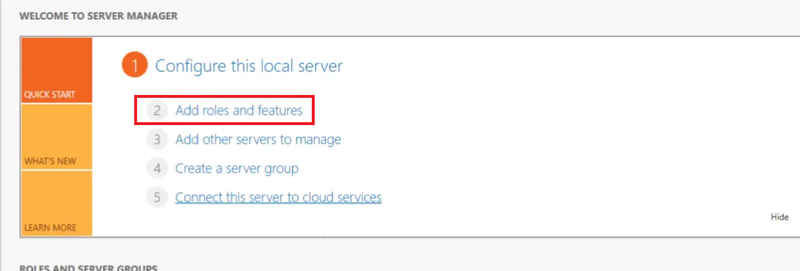
Step 2. Select Installation Type
Once the below page is displayed, choose the Role-Based or Feature-based installation radio option and click on the Next button.
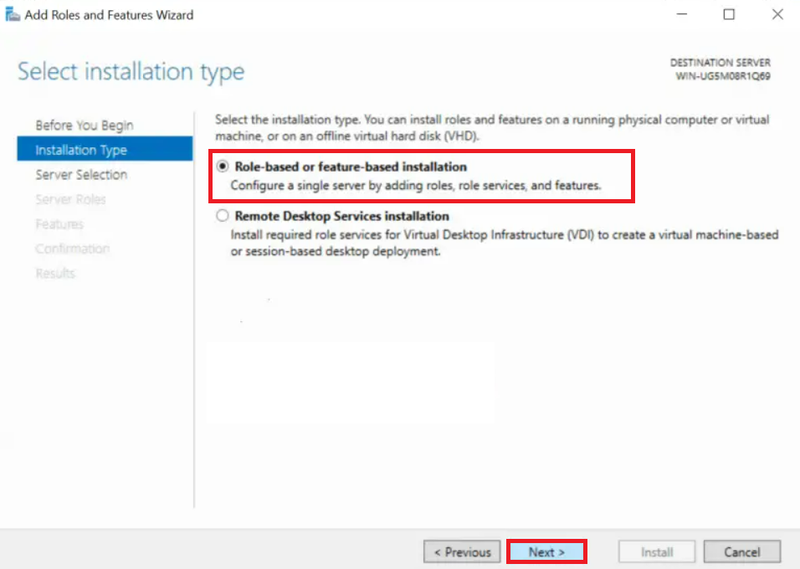
Step 3. Choose a Server to Install DHCP Role On
Select the server you want to install the DHCP Server on from the list on the page below. After choosing the Server machine that hosts your DHCP server, click Next.
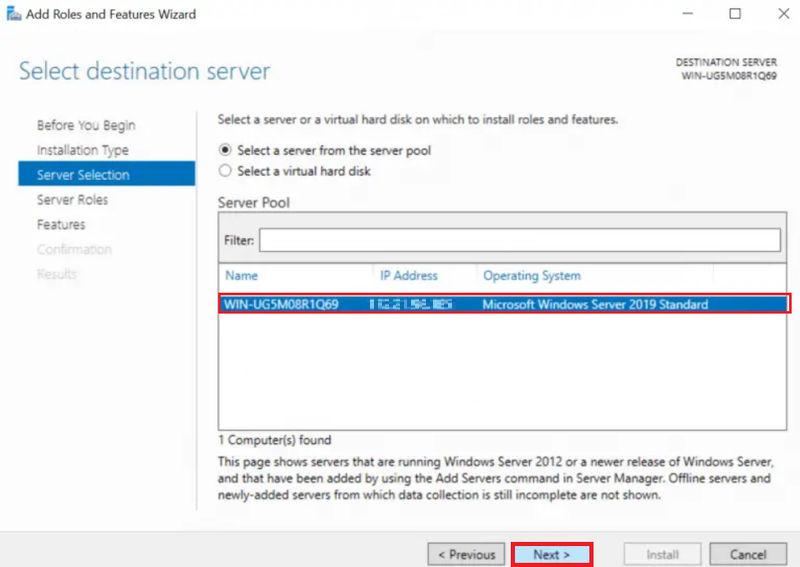
Step 4. Select Server Roles
In this step of Configuring DHCP Server in Windows, you need to Select Server Roles.
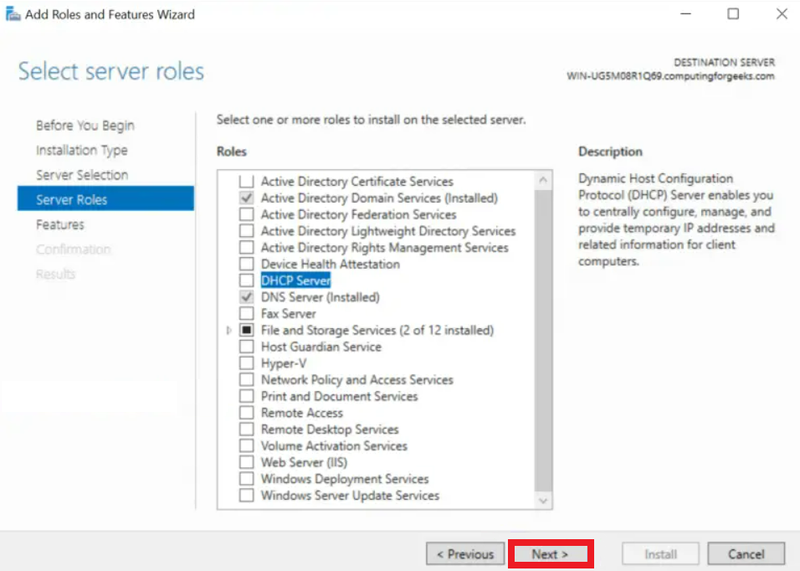
A pop-up window will appear when you choose the option, requesting that you add features needed by the DHCP server. If you want to add the DHCP management tools along with the DHCP role, keep the Include Management Tools checked selected. Then, click on Add Features and then click on the Next button to move on.
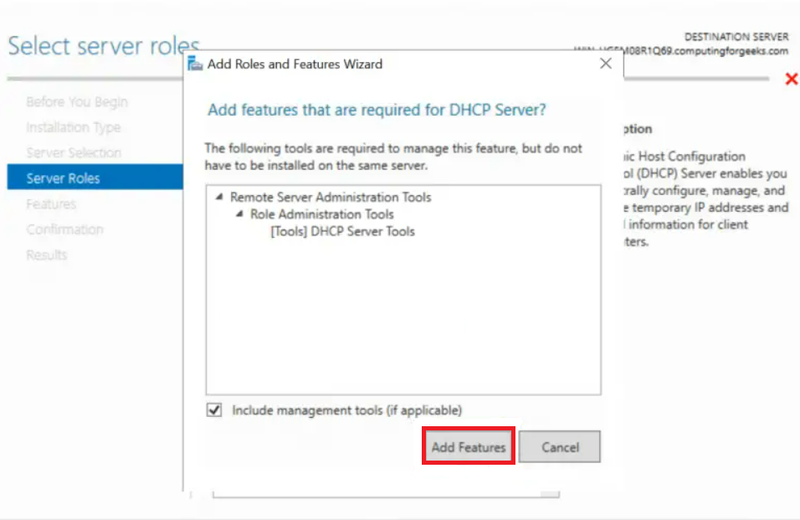
Step 5. DHCP Server
On the DHCP Server, click on Next and continue.
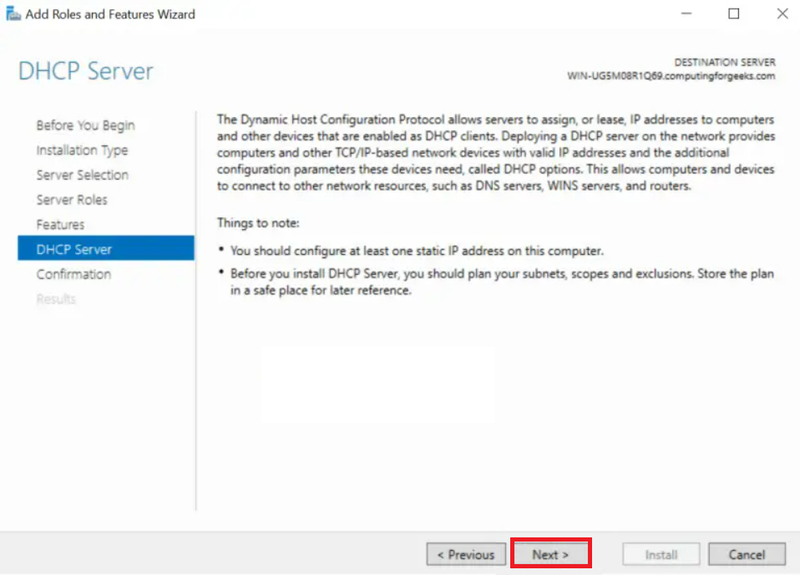
Step 6. Confirm Installation Selections
You are so close to finishing Configuring DHCP Server in Windows. In this step, verify that DHCP Server and other names are on the list by looking at it. Click “Install” after that. Click “Close” once everything has been installed successfully, and your DHCP server will be up and running.
Let’s start the DHCP post-deployment configuration process.
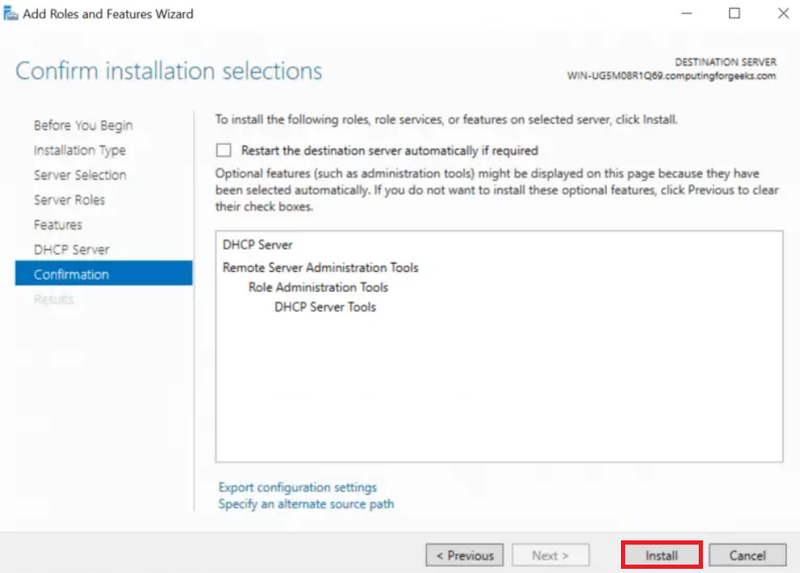
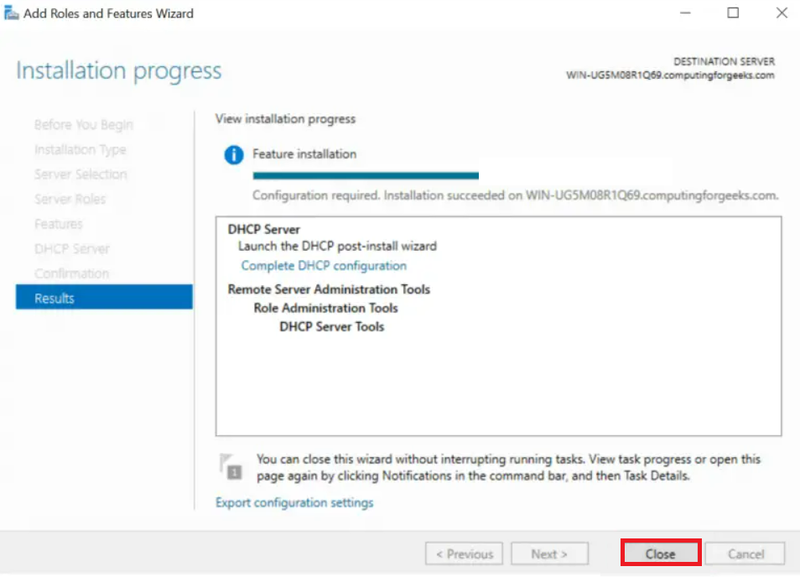
Step 7. Post-deployment Config
By now, you must complete the installation process. You are ready to start Configuring DHCP Server in Windows. The option “DHCP” should now be shown on the left pane of the window when you open Server Manager. A yellow-marked warning with the words “Configuration required for DHCP Server at…” and the link “More” should appear, as seen in the picture below.

The phrase “All Server Task Details and Notifications” will appear in a new window. You will see the “Post-deployment Configuration” line underneath it. As illustrated below, click on “Complete DHCP Configuration” at the end of that line. There will be an installation wizard. Choose “Next“.
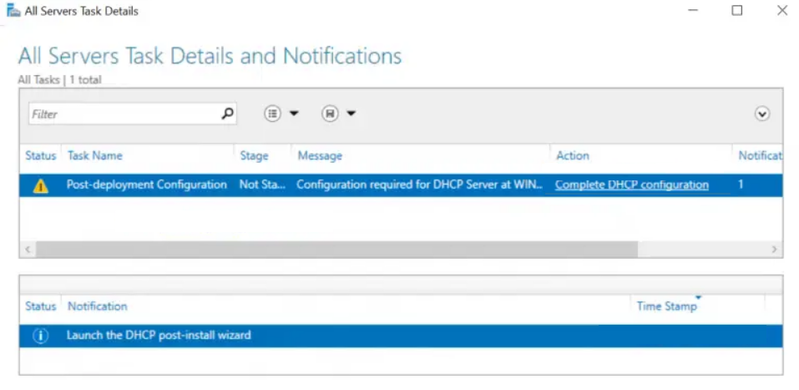
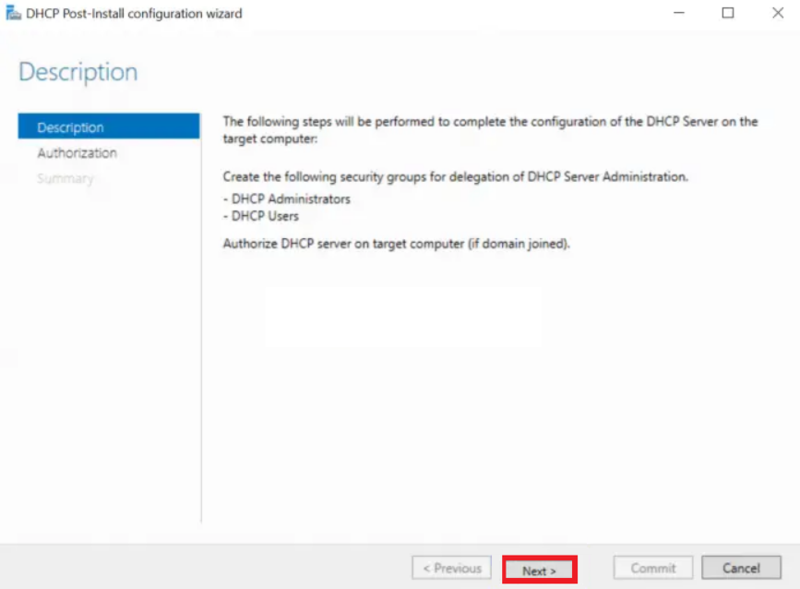
Three choices are offered to you on this Wizard page. You can move forward using the Administrator’s credentials, the credentials of a different user, and AD Authorization. Select the “Skip AD authorization” radio option if your server is standalone and is not a member of any Active Directory domain. If so, you should log in using the credentials listed in your AD. Click “Commit” once you’ve made a decision that works with your surroundings. Allow it to complete its task, and if it is successful, click “Close” with satisfaction.
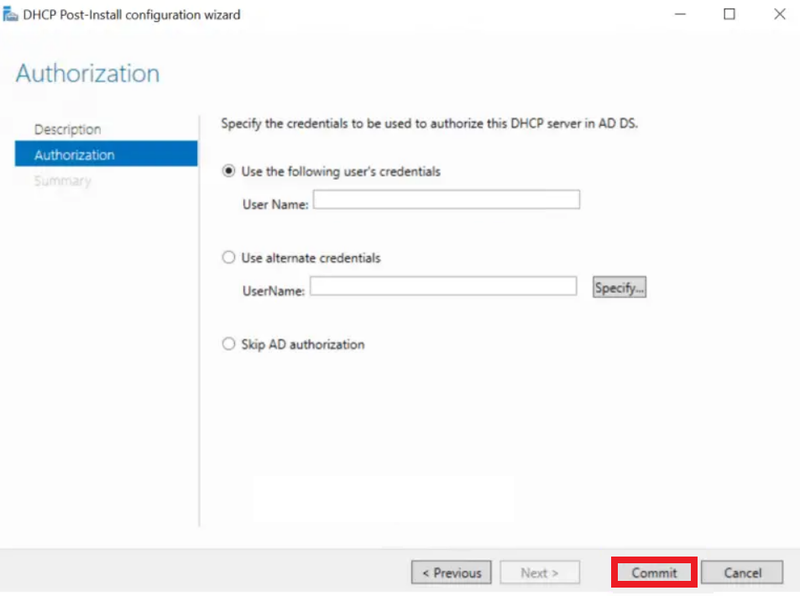
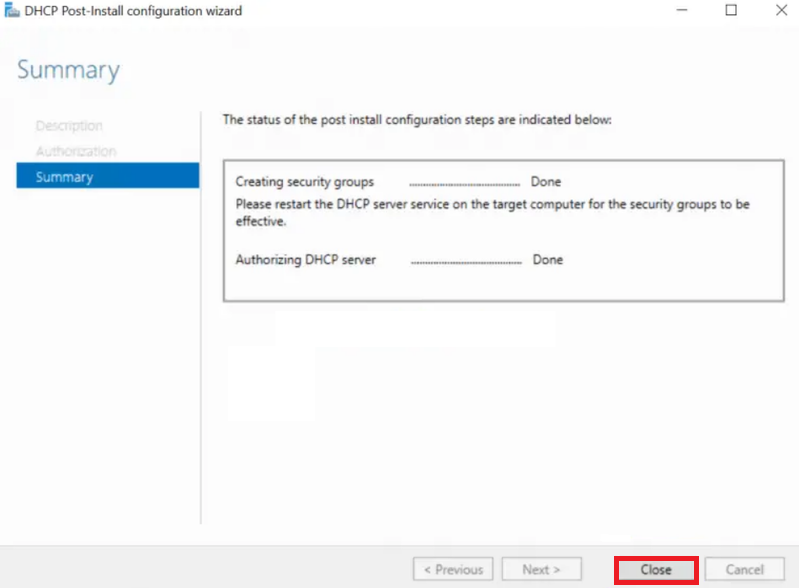
Step 8. Configure DHCP Server
To continue Configuring DHCP Server in Windows, return to Server Manager and select “DHCP” from the “Tools” menu. The DHCP Configuration Window will then open as displayed below.
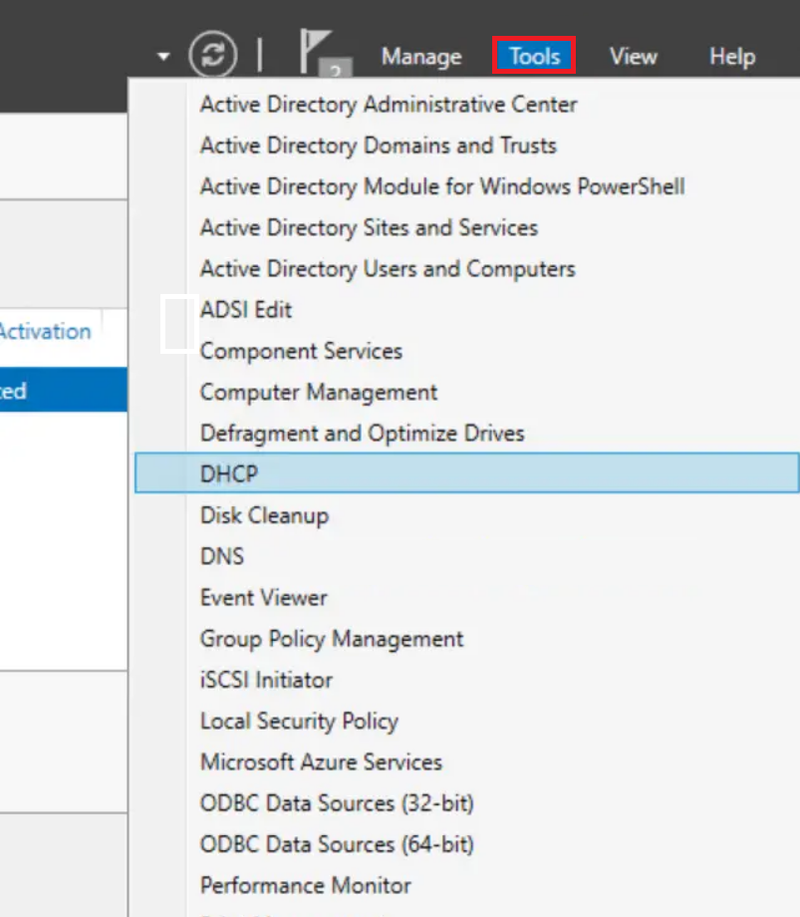
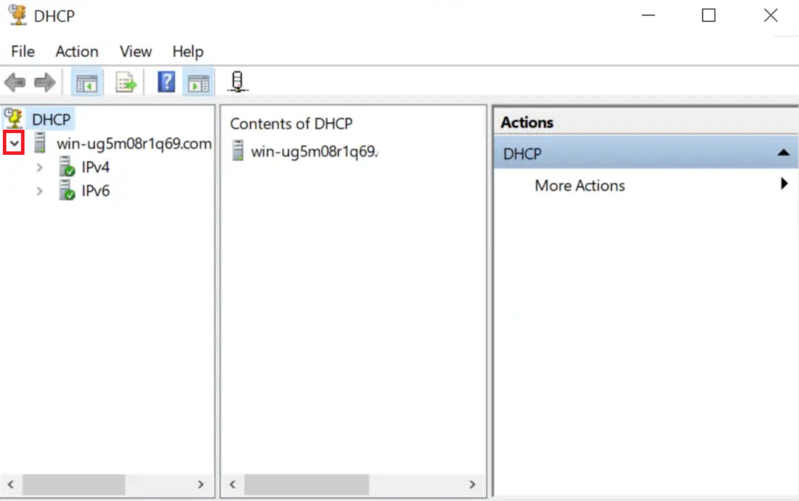
Step 9. Select New Scope
Click the drop-down arrow as indicated above, then right-click “IPv4” in the window’s left pane and select “New Scope“. As seen below, a new window for the scope wizard will open. Choose “Next”
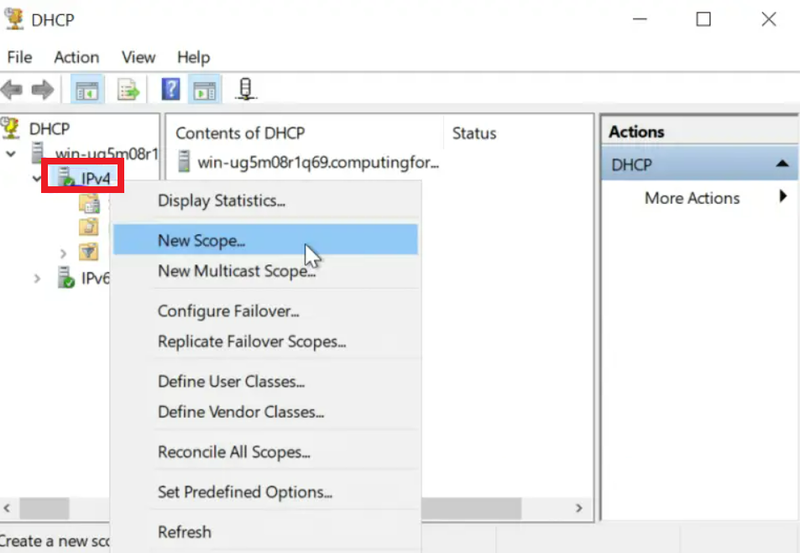
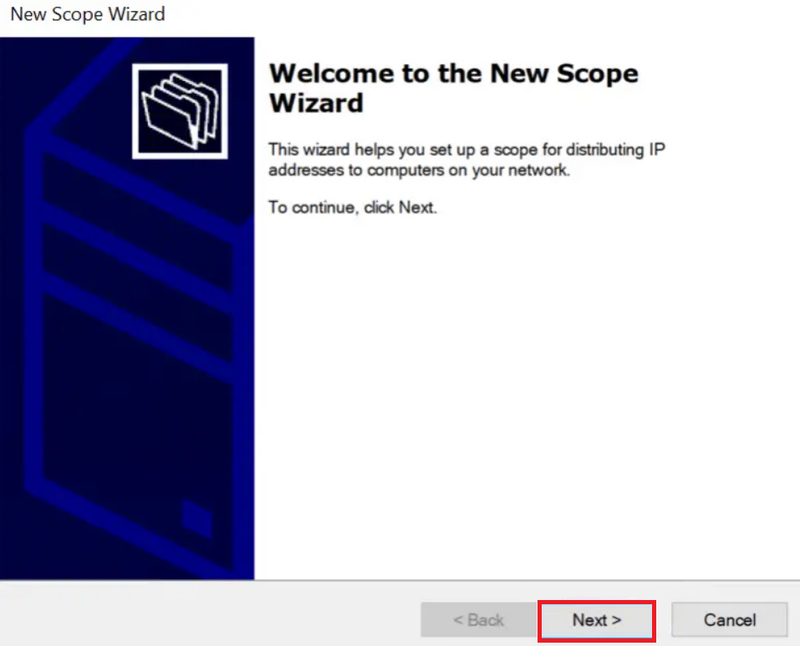
Step 10. Name your Scope
Select “Next” after entering the new scope’s name and description.
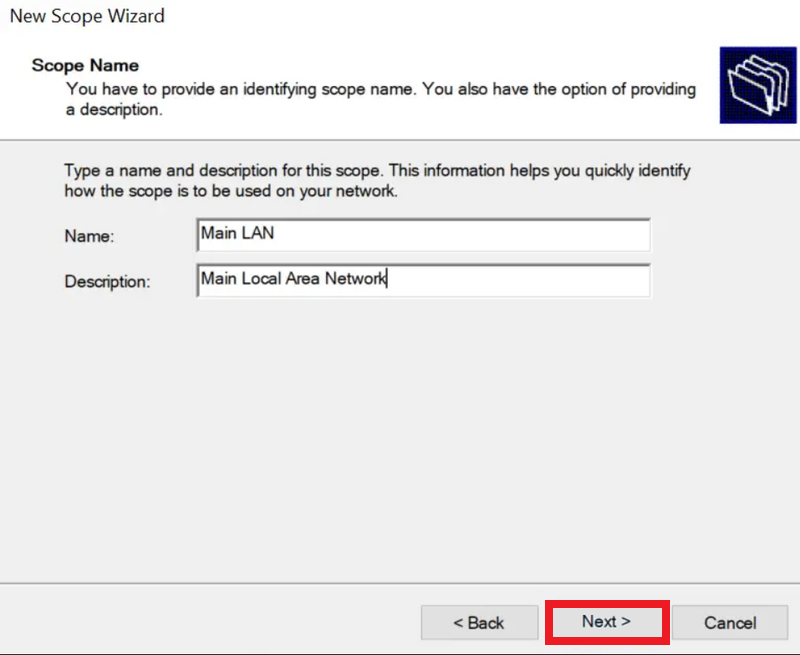
Step 11. Insert your IP Address Range
In this step, you need to input the preferred IP address range. To do this, input your start and End IPs, Length, and Subnet Mask. When you are finished, click on Next.
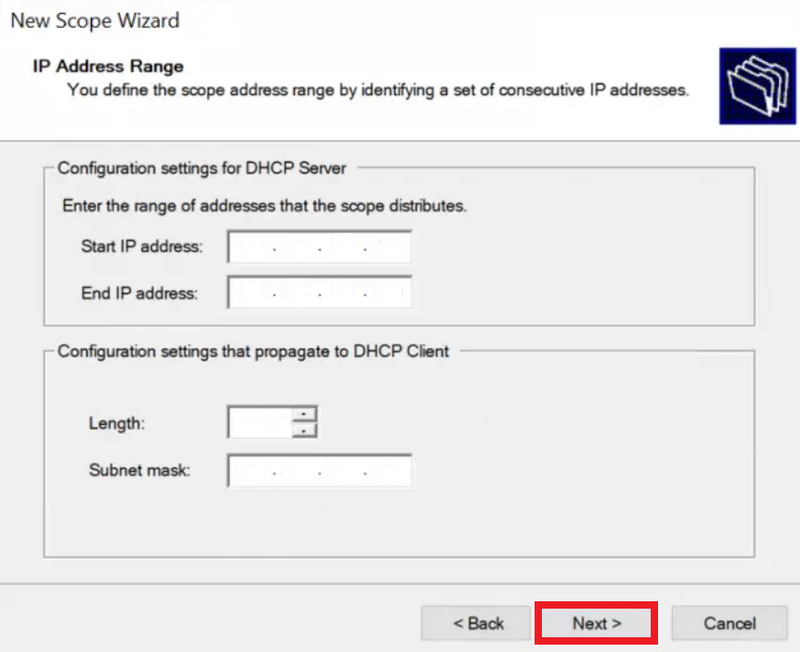
Step 12. Set any IPs you Consider excluding here
At this point, you can enter any IP addresses you want to reserve for possible future use with equipment like a printer and other devices.
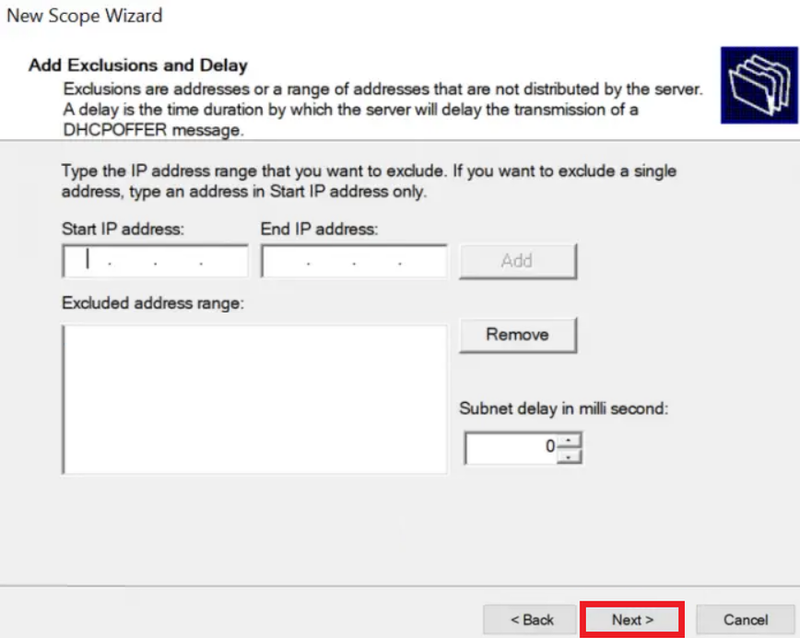
Step 13. Lease Duration
A computer or client will receive an IP address for the lease length until the DHCP server changes it or assigns a new one when the user logs in again. Hit “Next” after setting yours.
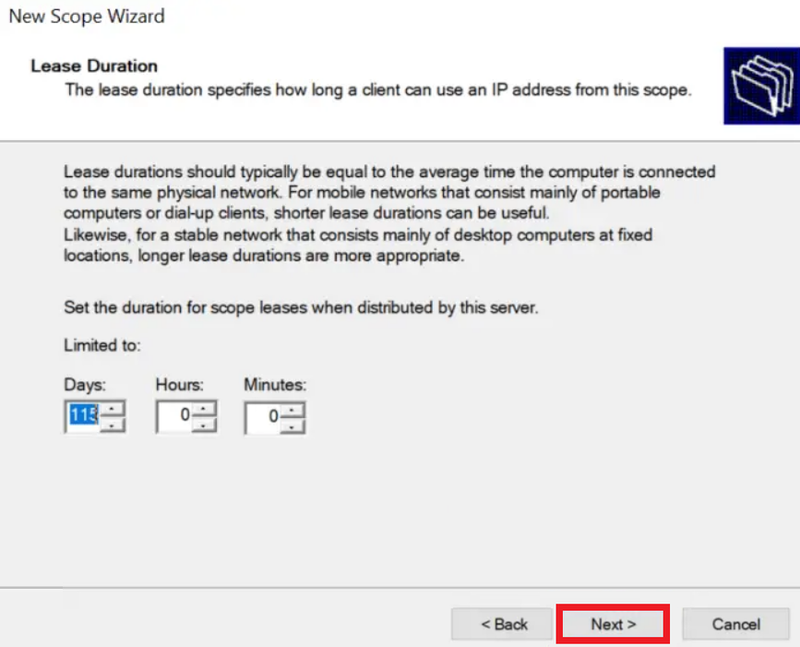
Step 14. DHCP Options
If you agree with the DHCP Options as they are shown on the page, simply click “Next” on this page.
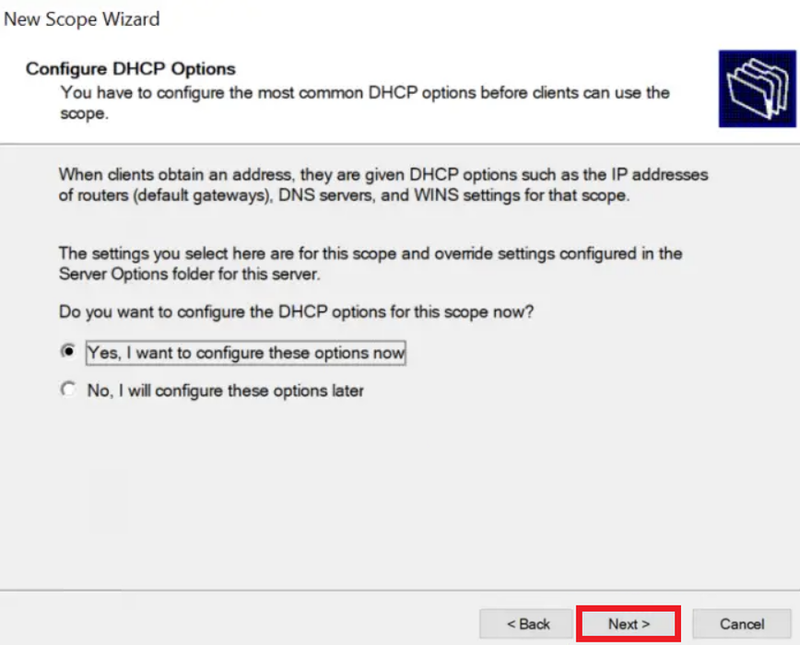
Step 15. Default Gateway
In this step of Configuring DHCP Server in Windows, you must enter the Default Gateway that will be given to the clients during the leasing period on this page. Enter it in and select “Add” next to it. Click “Next” after that.
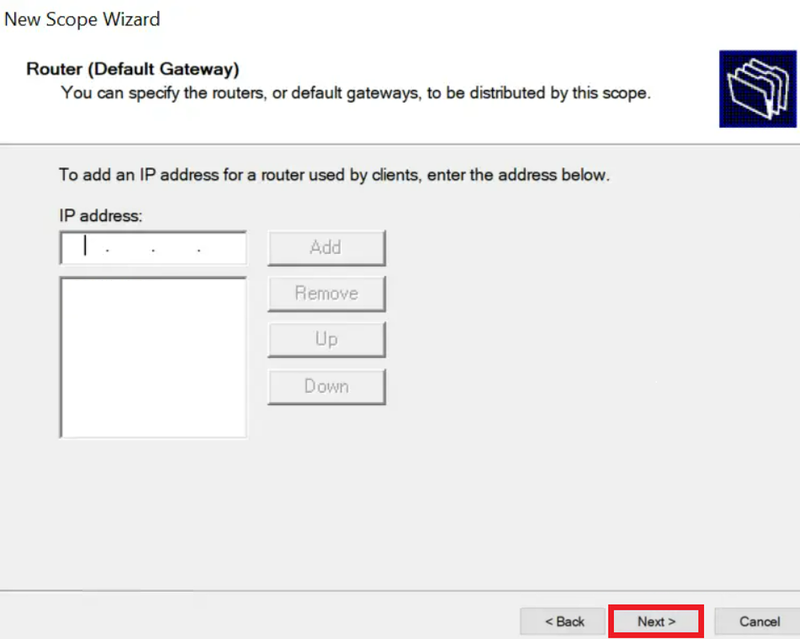
Step 16. Domain Name and DNS Servers
Previously, you got familiar with DNS Records and you know the DNS is crucial since it makes it easier to resolve FQDNs to IP Addresses. So, enter it and press “Next”
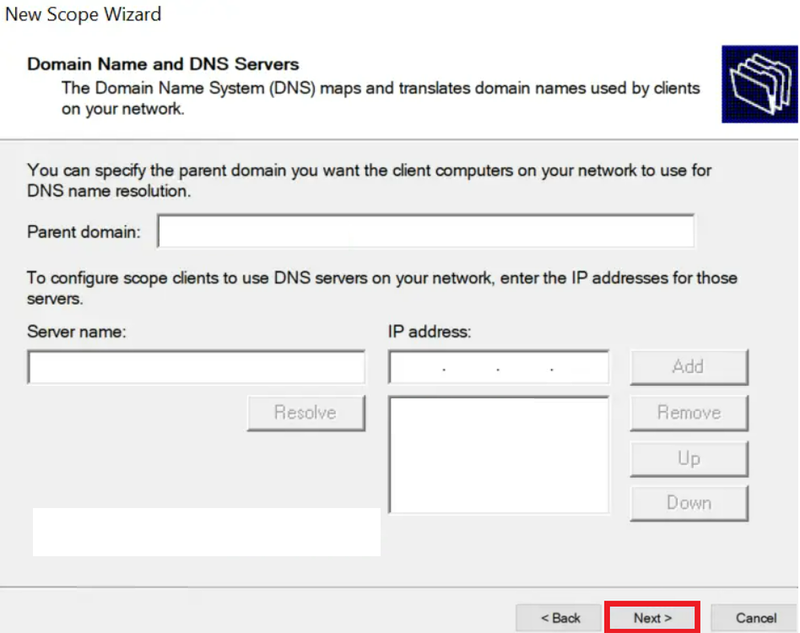
Step 17. Wins Servers
This step is optional. If you want to use WINS Server in your environment, enter the information below and click “Next” to continue.
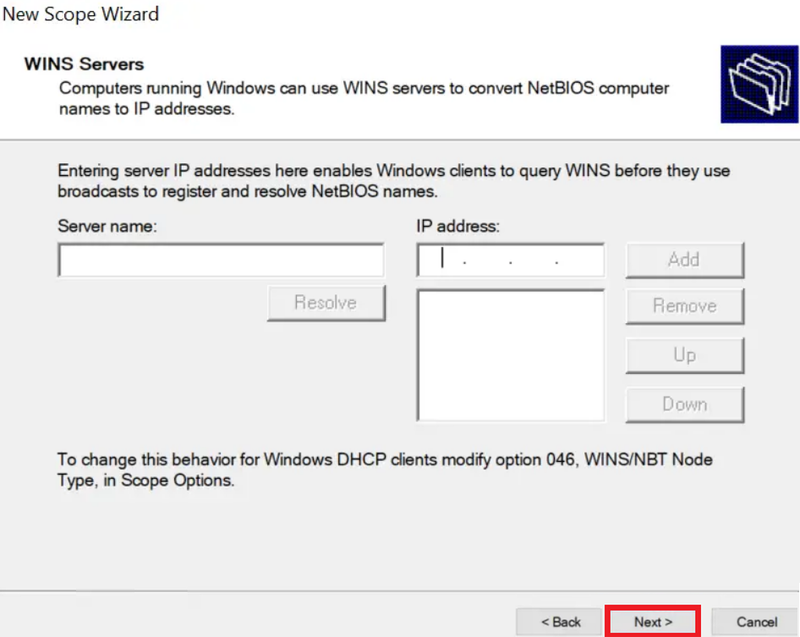
Step 18. Activate Scope
Simply click “Next” to activate the scope we have set for this Step. Pick the second radio option if you want to activate it later.
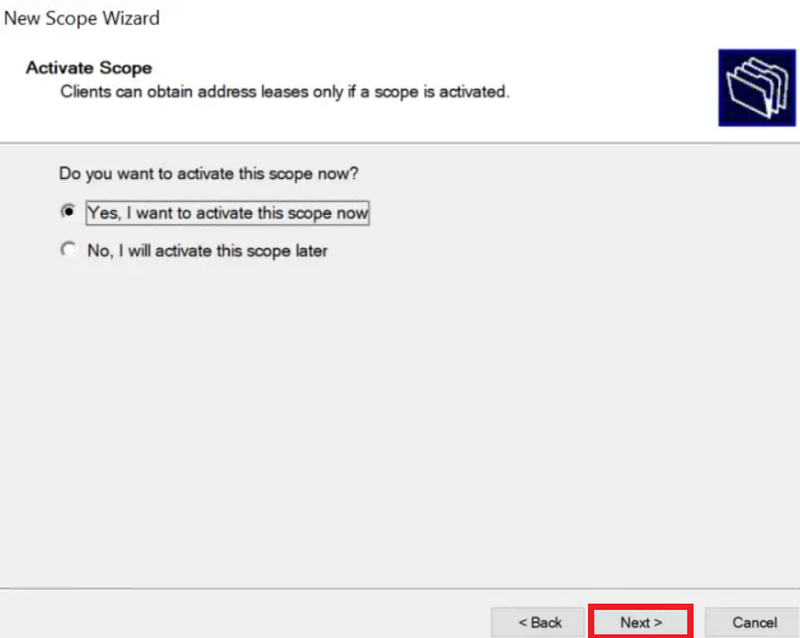
Step 19. Complete Scope Configuration
Configuring DHCP Server in Windows is now complete. Create additional scopes as shown above for the VLANS you have segmented in your LAN/Network, then set up your router so that it requests IP addresses from the DHCP server in accordance if you have done so.
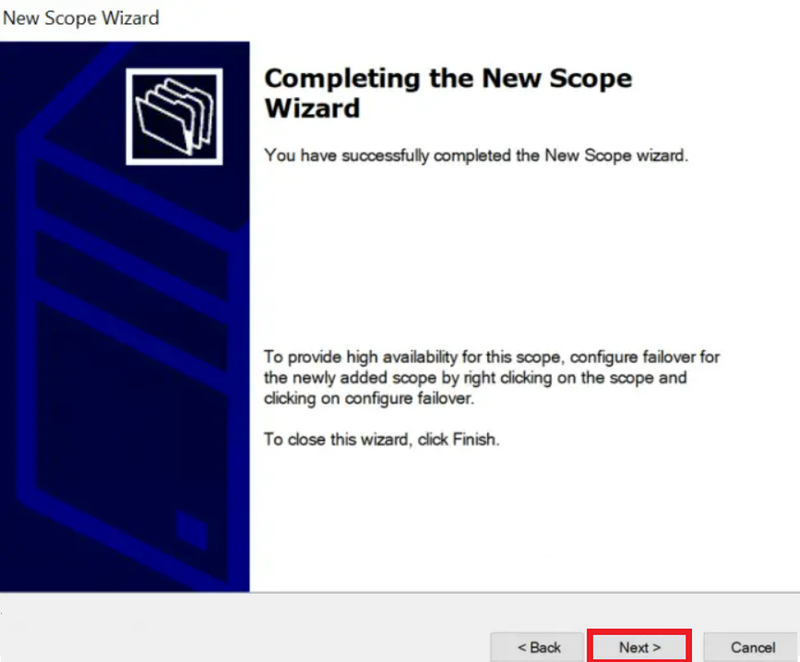
Step 20. Verify that your Scope is active and Set up
Check to see if your configs are present by opening your DHCP Configuration as in Step 9 and opening it as shown below.
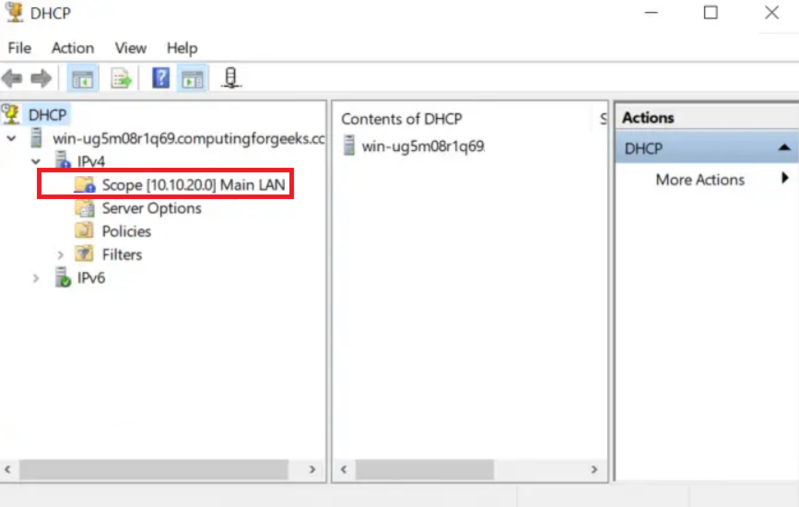
Step 21. Configure DHCP Client on Windows
The next step is to set up DHCP Client so that a Windows machine can request an IP address from DHCP Server after DHCP Server has been configured on our Windows server.
How to Access DHCP Manager Console [4 Methods]
A DHCP administration console is added to your server once the DHCP has been deployed and configured. You can further configure your DHCP server from this panel. There are multiple ways you can open this console on your Windows Server. Previously, you learned How to Install Microsoft Windows Server 2022. It is a good idea to open DHCP Manager Console on Windows Server 2022 since it is a perfect place to discuss some methods for opening this console.
Method 1. Windows Administrative Tools
You can start by demonstrating how to use Windows Administrative Tools. When you install them, other administration consoles, including DNS, are added in addition to DHCP. Anyhow, open Windows Administrative Tools from the Start Menu to access the DHCP management console using this technique. If it isn’t pinned in the Start Menu, you can search for it there. Click DHCP to open it once the Windows Administrative Tools are open.
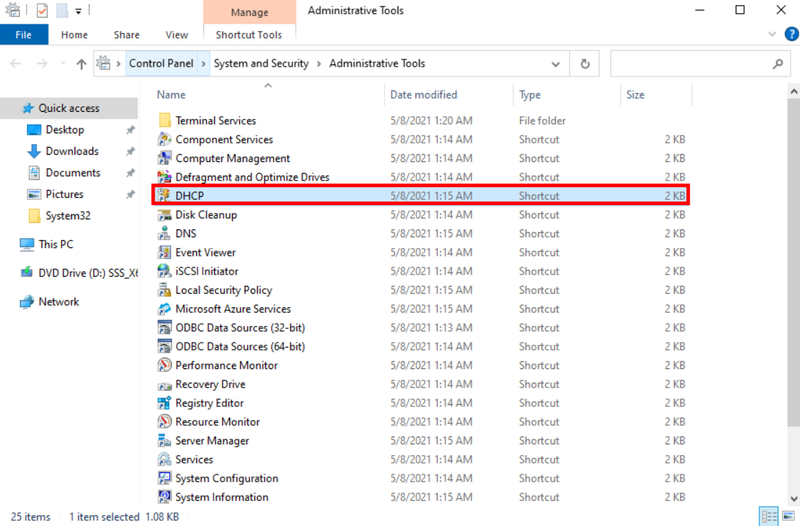
Method 2. Server Manager Console
Utilizing the Server Manager console is the second approach. The majority, if not all, of the features you add to your Windows Server, are added to the Server Manager’s Tools menu. These features include DHCP, DNS, and other things. Open the Server manager there to access the DHCP management. Next, pick DHCP from the list by clicking Tools.
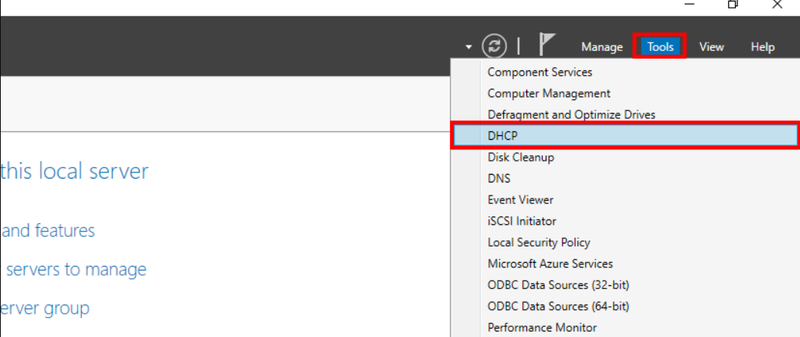
Method 3. Run Dialogue Box
Utilizing the Run dialog box is the third approach. Using this technique, launch Run by pressing the shortcut keys Windows + R. After that, type dhcpmgmt.msc and press Enter or OK.
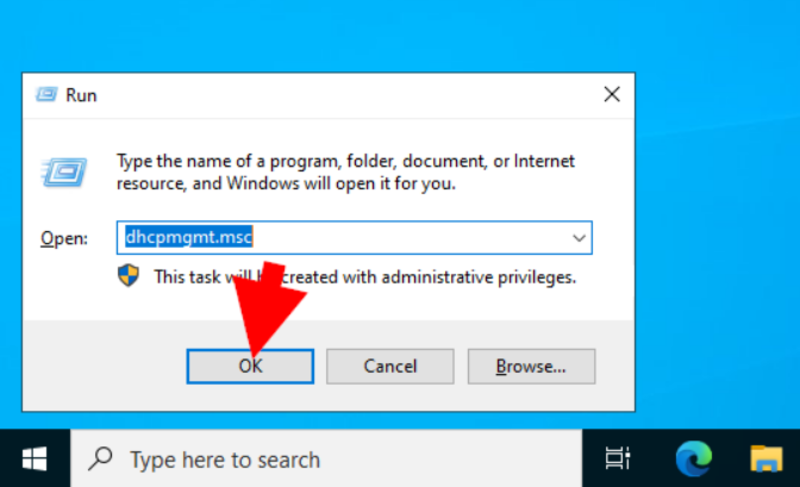
Method 4. Start Menu
The quickest and simplest method is Start Menu. The DHCP management console can be accessed easily from the Start Menu, much like the majority of other functions and tools. To open it, go to the Start Menu or click the Windows key while searching for DHCP.
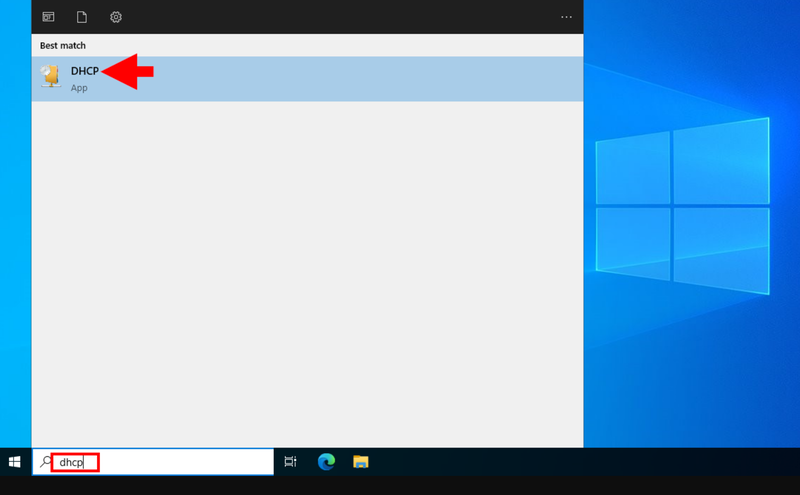
FAQ
Why my DHCP Server is unavailable
The DHCP service frequently does not start when a DHCP server fails to give leased addresses to clients. In this situation, the server might not have permission to use the network. If you were able to start the DHCP service in the past, utilize Event Viewer to look for any entries in the System log. These logs can shed light on the difficulty in starting the DHCP service.
How to restart the DHCP service?
Follow the below steps to restart your DHCP service:
Click Start, and then click Run.
Type cmd, and then press ENTER.
Type net start dhcpserver, and then press ENTER.
How to fix ‘’client was not able to connect a DHCP server’’ issue?
This occurs when a DHCP client does not have a configured IP address. Also, when facing a network problem or because the DHCP server is unavailable. Check that the client has a functioning network connection and that all associated client hardware devices are in good order once the DHCP server has been established and other clients can get valid addresses.
Conclusion
In this article, you reviewed all the required steps of Installing and Configuring DHCP Server in Windows Server. So far, you understand what DHCP is and the main reasons for instilling and configuring it on your Server. Also, you know how crucial a part it plays in network communications. In the end, multiple ways to Access DHCP Manager Console were explained.
If you follow the above steps properly then you can Configure DHCP Server in Windows without any errors but do not hesitate to contact us if you encounter any problems. Our technical support team will try their best to solve your problems.